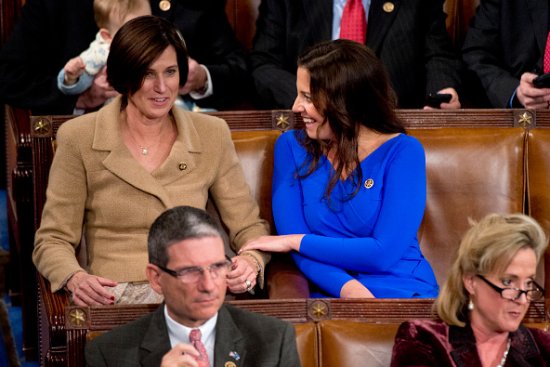
House Republican women have some advice for the largely male field of 2016 would be GOP presidential nominees hoping to take on Hillary Clinton: listen to us before you speak.
“Women are the majority!” exclaimed Rep. Martha McSally, an Arizona Republican, referring to the fact that America is 52% female. “We really have to watch our language when we’re talking about some of these issues. … The language just turns women off because we come off as the party of just cold, lack of compassion.”
McSally cited an exit poll in the 2012 presidential election that showed that 81.2% of voters felt President Obama “cared about people like me,” compared to just 17.6% of voters for Republican nominee Mitt Romney. Romney lost the election in large part because he lost women by 12 percentage points to President Obama. And though Republicans in 2014 won back the Senate and made gains in the House, they only incrementally added women: a net of two in the House and one in the Senate. And they net lost one female governor.
Pundits often talk about GOP demographic challenges with minorities and young voters, but since the so-called War on Women petered out after 2012— after Republicans figured out how to stop saying egregiously insulting things about rape, little has been said about the GOP’s biggest demographic challenge: women. “We have a problem,” said Mimi Walters, a California Republican and the freshman representative on the House leadership team, “and we’re working to address it.”
[time-brightcove not-tgx=”true”]The conservative National Review magazine and Google gathered five Republican Congresswomen—McSally, Walters, Missouri’s Ann Wagner, McSally, Walters, Virginia’s Barbara Comstock and New York’s Elise Stefanik—on Tuesday to talk about the challenges their party faces with women. All agreed that the GOP candidates needed to be consulting them, especially when the eventual nominee will likely be running against a woman: Hillary Clinton. “I will tell you: we will fail, and these men will fail, if they try and package [Clinton] as someone who’s stupid and doesn’t know her job, hasn’t done her job, and isn’t real, isn’t strong,” said Wagner, who is the sophomore class’ leadership representative. “They need us at the table to remind them of the words to use, the words not to use.”
All of the women said they had heard from one or more of the campaigns and were consulting with them and/or the Republican National Committee. They also spoke of their own efforts to find and elect more women to Congress, though they acknowledged that that effort was hamstrung by the limited number of competitive races given how gerrymandered congressional districts have become.
On the presidential level, Comstock said it was important that the campaigns hire senior women to run them, which could be a challenge because women don’t like to take risky jobs that may not lead to permanent employment should their candidate lose, Comstock said. So, she said, the campaigns had to be proactive and seek women out.
“One of the things I’ve asked them is: where am I at the table? Who do you have on staff?” Comstock said. “The reality is if there are women at the top they recruit other women and bring them in and that is also something I have been demanding of the candidates.”
So far the candidates don’t seem to be listening too closely. Only one major candidate has a female campaign manager: Mike Huckabee’s daughter Sarah is running her dad’s bid. A quick search reveals that of the top 16 GOP candidates, only Wisconsin Gov. Scott Walker, former Texas Gov. Rick Perry and Kentucky Sen. Rand Paul have set up “Women for…” pages on Facebook.
That said, former Hewlett Packard CEO Carly Fiorina—one of the 13 without a dedicated page for women—has spent a lot of time courting the women’s vote. “I hope she makes the top 10, I think she’s been very effective in going after Hillary Clinton,” said Wagner, referring to the debate cutoff of the top 10 candidates in polling. “I think she’s done it in a way that’s responds with women.”
In the latest round of surveys, Fiorina broke into the top 10 for the first time, with 3% of the vote.